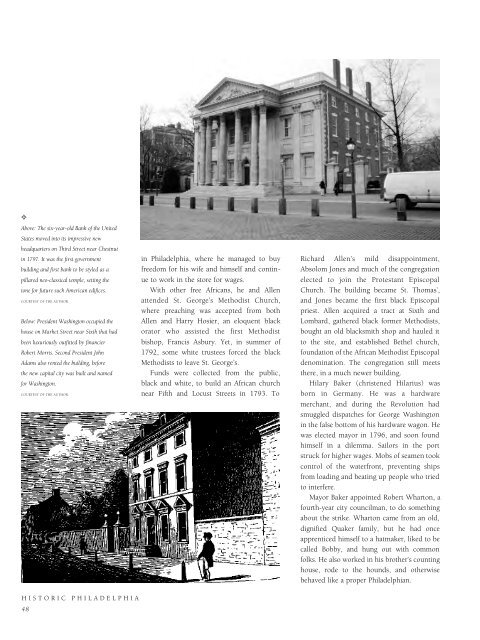Historic Philadelphia
An illustrated history of the city of Philadelphia, paired with the histories of companies, families and organizations that make the region great.
An illustrated history of the city of Philadelphia, paired with the histories of companies, families and organizations that make the region great.
You also want an ePaper? Increase the reach of your titles
YUMPU automatically turns print PDFs into web optimized ePapers that Google loves.
✧<br />
Above: The six-year-old Bank of the United<br />
States moved into its impressive new<br />
headquarters on Third Street near Chestnut<br />
in 1797. It was the first government<br />
building and first bank to be styled as a<br />
pillared neo-classical temple, setting the<br />
tone for future such American edifices.<br />
COURTESY OF THE AUTHOR.<br />
Below: President Washington occupied the<br />
house on Market Street near Sixth that had<br />
been luxuriously outfitted by financier<br />
Robert Morris. Second President John<br />
Adams also rented the building, before<br />
the new capital city was built and named<br />
for Washington.<br />
COURTESY OF THE AUTHOR.<br />
HISTORIC PHILADELPHIA<br />
48<br />
in <strong>Philadelphia</strong>, where he managed to buy<br />
freedom for his wife and himself and continue<br />
to work in the store for wages.<br />
With other free Africans, he and Allen<br />
attended St. George’s Methodist Church,<br />
where preaching was accepted from both<br />
Allen and Harry Hosier, an eloquent black<br />
orator who assisted the first Methodist<br />
bishop, Francis Asbury. Yet, in summer of<br />
1792, some white trustees forced the black<br />
Methodists to leave St. George’s.<br />
Funds were collected from the public,<br />
black and white, to build an African church<br />
near Fifth and Locust Streets in 1793. To<br />
Richard Allen’s mild disappointment,<br />
Absolom Jones and much of the congregation<br />
elected to join the Protestant Episcopal<br />
Church. The building became St. Thomas’,<br />
and Jones became the first black Episcopal<br />
priest. Allen acquired a tract at Sixth and<br />
Lombard, gathered black former Methodists,<br />
bought an old blacksmith shop and hauled it<br />
to the site, and established Bethel church,<br />
foundation of the African Methodist Episcopal<br />
denomination. The congregation still meets<br />
there, in a much newer building.<br />
Hilary Baker (christened Hilarius) was<br />
born in Germany. He was a hardware<br />
merchant, and during the Revolution had<br />
smuggled dispatches for George Washington<br />
in the false bottom of his hardware wagon. He<br />
was elected mayor in 1796, and soon found<br />
himself in a dilemma. Sailors in the port<br />
struck for higher wages. Mobs of seamen took<br />
control of the waterfront, preventing ships<br />
from loading and beating up people who tried<br />
to interfere.<br />
Mayor Baker appointed Robert Wharton, a<br />
fourth-year city councilman, to do something<br />
about the strike. Wharton came from an old,<br />
dignified Quaker family, but he had once<br />
apprenticed himself to a hatmaker, liked to be<br />
called Bobby, and hung out with common<br />
folks. He also worked in his brother’s counting<br />
house, rode to the hounds, and otherwise<br />
behaved like a proper <strong>Philadelphia</strong>n.
















